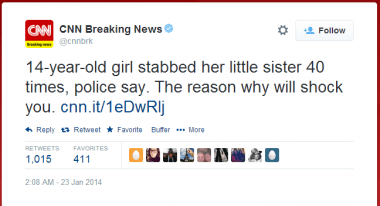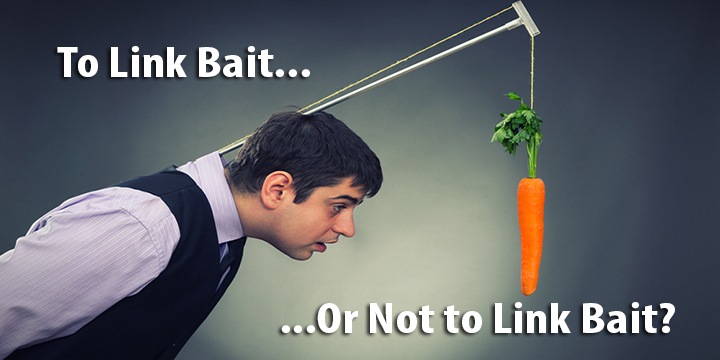Did you click on a link to this article based on the title? Good. My link bait worked.
Isn’t that the point? To get you here. But there are people who are so concerned with SEO that they’d (almost) do anything to drive traffic to their site. And guess what? It works. Every time I see a title that intrigues me I click on it. I fall for it over and over. Sometimes the click is worth it. Sometimes it’s not.
Link baiting seems to be quite a trendy way these days to attract potential viewers. It is essentially generating compelling or useful content that will naturally lure people to a website. It can be fun (I know I laughed after I wrote the title for this piece) and has the ability to attract some very big SEO results. Link baiting is not new. Check out this article on CopyBlogger about the history of link baiting. It is, however, getting better and more engaging.
Now lets be clear about why people use link baiting. The main goal is to increase the number of external links and shares, rather than website visits and sales. The idea is to improve your rankings and hopefully increase your organic search results over a period of time.
Are Link Bait Titles Really All They Are Cracked Up To Be?
Some people like link baiting and some don’t. It’s just another way to get people interested in your story. Ann Simmons says it best in this line from her highly regarded book The Story Factor. The jargon she uses demonstrates link baiting:
“We try to “hook ‘em” and “reel ‘em in.” … Your story is the bait. If a fish doesn’t bite do you blame the fish? Do you call the fish unmotivated, lazy, greedy? No, you look for better bait.
Sites like Upworthy and BuzzFeed thrive on link bait titles in order to draw visitors to its site, which is fine with them because they get paid to sell advertising to its audience.
And while link baiting can bring visitors to your site, many people are growing tired of it. You won’t believe what people are doing it to stop them, and the results will shock you.
Ok, I’m being a bit sarcastic here, but you get my point. In all seriousness though, there are things like a Google Chrome plugin called Downworthy (get it?). In a nutshell, this plugin claims that it will reflect the article story more realistically, instead of showing you hyperbolic headlines. My personal favorite is “go viral” will be replaced with “be overused so much that you’ll silently pray for sweet release of death to make it stop”. Others include replacing “literally” with “figuratively” and “incredible” into “painfully ordinary”.
This means that instead of being annoyed by these headlines, you’ll find them wildly entertaining. Since you’re going to be bombarded with link baits on a daily basis (remember that part about it being trendy these days?), you might as well try to enjoy them.
Instead of being annoyed, some are actually downright offended by them.
 Back in January, CNN posted a tweet that went viral, but also got a lot of backlash for it. It said “14-year-old girl stabbed her little sister 40 times, police say. The reason why will shock you. http://cnn.it/1eDwRlj”. Many people not only retweeted it, but people responded that they wouldn’t take CNN seriously anymore.
Back in January, CNN posted a tweet that went viral, but also got a lot of backlash for it. It said “14-year-old girl stabbed her little sister 40 times, police say. The reason why will shock you. http://cnn.it/1eDwRlj”. Many people not only retweeted it, but people responded that they wouldn’t take CNN seriously anymore.
Do you think CNN really thought it through when they thought about how they wanted to drive traffic to their site?
Here Are Some SEO Problems With Link Bait, And The Results Will Make You Cry
As demonstrated with the examples above, not only can bad link bait not be effective, but it can have some very serious consequences down the line for your SEO regarding the relevance of your content, and the kinds of links you earn. Some websites have even suffered Google penalties because of how bad their link bait is.
There isn’t really a benchmark for bad link baiting, but here are some characteristics that help to define what bad link baiting is:
- Infographics without quality information
- Creating controversy for the sake of controversy
- Content that is barely related to topic at hand, or totally off-topic
Link Baiting and ROI
So what does this mean? Is link baiting good for ROI or not? Yes it is, when done right. You just never know what Google has up its sleeves, so what you do today could be penalized down the line. Also, be careful. If people hate your content because they were tricked by the title, what are the chances they will share it? And if they don’t share it, how will the traffic you gain lead to loyal followers and customers?
Isn’t There A Way I Can Still Use Link-Baiting?
Yes, in fact it can be quite easy. Instead of pouring your energy into finding easy solutions, use that time to create one piece of link bait that is not only relevant, but highly valuable for your readers. This is what is known as a linkable asset.
Ask yourself the following questions and see if your linkable asset is actually worth making:
- Does it help make the viewer’s life easier?
- Will it be used over and over again?
- Will it provide value that is actually practical?
- Will it reveal any new knowledge or insight?
- Will it get a strong emotional response?
Link baiting with Linkable Assets
The idea is to merge the idea of link baiting with linkable assets, so you not only draw your visitors in, but with the value you provide them, you get them to stay.
Every day online, both great and not so great articles live or die by the quality of their title.
As content creators, we have just one line of text to include a keyword or phrase that might match a search keyword or engage an audience who will make a final judgment on the quality of the content piece in real-time. As a matter of fact, many usability studies show Internet users generally scan headlines, link lists, or status updates.
Writing titles is a serious matter and the success of your campaign depends on it. Here are some of key factors our Rob Garner tells says you should consider when writing engaging headlines:
- Write an Engaging Heading That Readers Will Quickly Understand: How would you describe your article or digital asset in seven to 10 words? Be clear and succinct, and cover at least one of the captivating ideas or features of your digital asset.
- Accurately Describe What the Reader Should Expect to See: Make your title relevant, because your audience does not like to be tricked. They will appreciate the truthfulness in consistency between the title and actual content. The same goes for search engines—don’t try to stuff irrelevant keywords into your title, because engines’ algorithms can detect this type inconsistency and will ignore your content altogether.
- Reveal an Outcome of the Article or a Provocative Question That the Article Might Answer: What thoughts or conclusion would you like your reader or consumer to walk away with after clicking through to read or view your content? Entice your audience by asking a question or providing the answer in the title, and be sure that your content lives up to your title. Sample titles include “How a Graffiti Artist Earned $200 Million on the Facebook IPO” and “Is Google Making Us Stupid?”.
- Use a Relevant Keyword or Keyword Phrase in the Title: Keywords are connections to people who use social networks. A good keyword in the title that reflects the literal theme of the article or asset will ultimately determine whether it ranks in search and social. If you are writing a 10,000-word review of the best hotels in New York City, it would be beneficial to include the relevant phrase “New York City Hotels” somewhere in the title to reinforce the main theme for your audience and for search engines. Not all articles have an exact keyword fit, though most should. If you do not place a keyword in this highly competitive spot, don’t expect to automatically rank in search, because search engines still apply heavy weight to this page element.
What if you don’t know how? Start by using a nifty tool called MOZ Worthy to help you come up with some headlines. Just plug-in your link, what kind of response you want to get from viewers, and away you go.
By the way, did you even notice that I did not even mention Matt Cutts. That there is no Tip # 5? Does that piss you off or did you enjoy my article on “To Link Bait or Not to Link Bait?” Let me know. Cheers!
Screen shot from https://twitter.com/cnnbrk/status/426265271914205184




